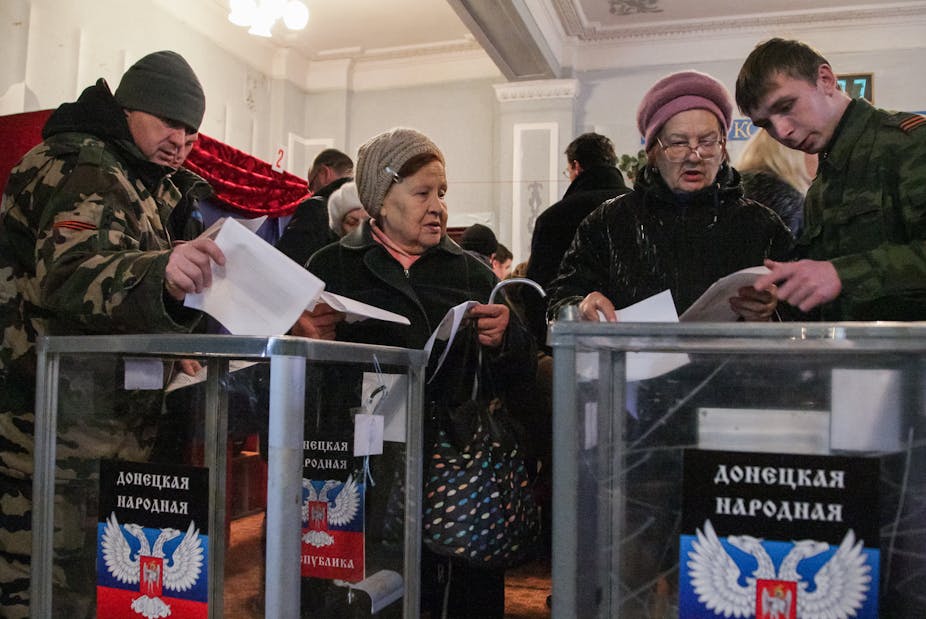Much of the world may regard the elections that took place in the Donetsk and Luhansk People’s Republics on November 2 as illegitimate, but there appears to be little political will to avert the most likely outcome: the partition of Ukraine.
Derided by Ukrainian president Poroshenko as a farce, there had been speculation that elections would be marred by violence. Fighting between Russian-backed rebels and pro-Kiev forces escalated in the days immediately prior to the election, despite the Minsk ceasefire agreement reached in September.
Witnesses described intensified rebel troop movements, and it was unclear whether this was the precursor to a renewed assault on pro-Kiev forces or simply heightened security for the vote.
It had even been suggested that the Donetsk People’s Republic (DNR) rebels might resort to “false flag” provocations to give the impression that pro-Kiev forces were once again shelling civilian communities. In the event, the election passed peacefully, and the majority of Precinct Election Commissions opened, although shelling could be heard in Donetsk as the polls closed.
Stand up and be counted
As there was no functioning electoral register, it is impossible to accurately calculate the turnout; however, according to the DNR’s Central Election Commission, 1,120,000 voted, including 104,500 who voted over the internet.
In order to vote, anyone older than 16 could visit a precinct, many situated in locations used for Ukrainian elections in the past, be added to the voter list by showing their passport which shows their registered address, and be given the two ballot papers: one to choose the prime minister, and the other to choose a “movement” to be represented in the 100-seat DNR Supreme Soviet.
In an improvement from the self-rule referendum held on May 11, voting booths were provided – but it was unclear what prevented voters from voting in multiple precincts and online.
A large number of people are genuinely pro-republic and anti-Ukraine, perhaps as much as 50% of the population. Still, voters were lured to the precincts by other things besides. After all, being registered as having voted might get people much-needed pension and welfare benefits, or at least the chance to buy fresh vegetables at knock-down prices. That meant long queues of mainly elderly voters all over the Donbas.
On the flipside, some would-be voters were reluctant to be recorded as having voted, fearful that they could be subject to reprisals if pro-Kiev forces retake the city and region. Many anti-DNR residents who have not yet left the region simply boycotted the vote entirely.
Taking control
Voters had little choice on the ballot papers. The only recognisable candidate for prime minister was Alexander Zakharchenko, leader of the Oplot militia and acting prime minister since August. His campaign lacked specific pledges, except for the aim to recapture key cities that were lost during the proxy war in July.
Zakharchenko won easily, securing 765,340 votes to his nearest rival’s 111,000. For the Supreme Soviet, voters could choose between Zakharchenko’s movement (simply called “Donetsk People’s Republic”), which secured 64.43% of the vote, or the “Free Donbas” movement, which won 27.75%. Only the top three candidates of the two party lists were named on the ballot paper, and their policy programmes were unclear.
For the leaders of the DNR and their supporters in Moscow, the hope is that the elections will earn the breakaway statelets some kind of political and legal legitimacy, both internally and externally.
The DNR has so far been a rag-bag of competing militias all running their own fiefdoms, meaning Zakharchenko’s writ did not travel very far from Donetsk city. To be sure, the Donbas’s armed revolution has chased out the region’s oligarchic elite, who have mostly scuttled off to Kiev – but it remains to be seen whether the vote will actually consolidate the DNR’s power structure.
Drawing the line
There are some signs of movement. It could be significant that Igor Bezler, a rival of Zakharchenko’s known as “the Demon”, is reported to have left his fiefdom in Horlivka just before the election.
But the DNR’s leaders need to prove their competence by keeping the heating and lights on during the harsh winter to prevent a humanitarian crisis. By the same token, they must secure funding for salaries, benefits and pensions to keep the DNR’s economy functioning. In the medium term, the region’s leaders need to craft a positive vision of the future of their breakaway state.
As for Russia, the running assumption around the world has been that Moscow’s interest in the Donbas was principally a strategy to wield influence in Kiev. However, Kiev’s pro-Western spasm in the wake of the Ukrainian parliamentary election saw some suggest that Kiev jettison the breakaway Donbas altogether; equally, Russia may simply give up on influencing Ukraine, and concentrate on helping create a functioning, Russia-friendly state in the east.
But that raises the question of whether the current borders actually allow for a viable state. And it’s still possible that Russia could decide it’s still worth using military force to help the rebels extend their territory – either before the full force of winter sets in, or after the start of the spring thaw.
In any case, with Kiev’s mood turning sour and the rebels spoiling for the next fight, no genuine peace process looks set to take hold anytime soon. It would appear that the Donbas is not yet a frozen conflict.

